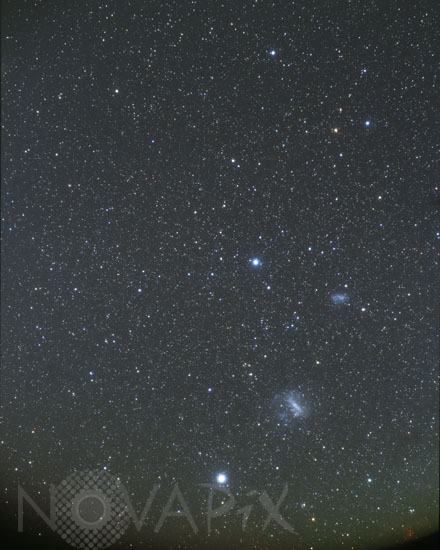Photo Agency - Astronomy - Space - Nature

Southern constellations around Horologium
author: A.Fujii/David Malin Images/Novapix
reference: a-cst98-00055
Image Size 300 DPI: 40 * 51 cm
This wide angle image includes Horologium, Phoenix and Pictor, insignificant constellations roughly centred on an arc of delination 50° south, but at a scale too small to show the star identifications and stick figures. Horologium, the Pendulum Clock (originally l'Horloge and then Horologium Oscillitorium), was a constellation introduced by Abbé Nicolas Louis de Lacaille during his stay at the Cape of Good Hope between 1751 and 1752. It was named to honor Christian Huygens as the inventor of this type of clock, but the idea for such a method of regulating time came from Galileo. Lacaille's constellation drawing shows a remarkably detailed dial, weights and a pendulum that has little apparent connection with the scattering of faint stars in this part of the sky. There are no named stars and little else in Horologium to attract the eye of the casual observer. Phoenix, the Phoenix, is a long-lived mythological, eagle-like bird with vivid plumage. The word has entered the language as an entity that is able to resurrect itself after a firey death in its nest. The cycle of death and rebirth may have symbolised the rising and setting of the Sun. On the sky Phoenix is hemmed in on two sides by other birds in Grus and Tucana and a large snake in the form of Eridanus. The constellation was invented by the Dutch navigators Pieter Dirkszoon Keyser and Frederick de Houtman, and first appeared in Johan Beyer's altas of 1603. The only named star in Phoenix is Ankaa. Pictor was also named by Lacaille during his sojourn at the Cape of Good Hope. He originally called it le Chevalet et la Palette, the easel and palette and later Equuleus Pictorius, soon shortened to Pictor. It requires the imagination of an artist to find anything like an easle here. The constellation runs between Canopus and the Large Magellanic Cloud and is devoid of named stars.
Â
Keywords for this photo:
ACHERNAR - ASTRONOMY - CAELUM - CANOPUS - COLUMBA - CONSTELLATION - DORADO - FORNAX - GALAXY - GRUS - HOROLOGIUM - HYDRUS - IRREGULAR GALAXY - LARGE MAGELLANIC CLOUD - MENSA - OCTANS - PHOENIX - PICTOR - PISCIS AUSTRINUS - POSTER - RETICULUM - SCULPTOR - SMALL MAGELLANIC CLOUD - SOUTH CELESTIAL POLE - SOUTHERN HEMISPHERE - STAR - TUCANA -
Contact : Stéphane Aubin +33-(0)9-51-26-53-76
© Novapix - All rights reserved


